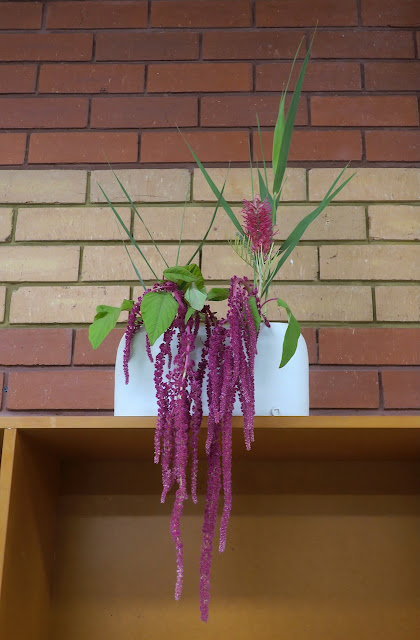At a recent class in Geelong ...
...Jo made an ikebana "Using green materials only". Although the Sogetsu curriculum does not specifically state the number of materials to be used in the exercise, I think, as a generalisation, three should be the minimal number, (sometimes exceptions are appropriate). In this example Jo used Mirror Bush Coprosma repens, Agapanthus and a large Tree Philodendron Thaumatophyllum bipinnatifidum.
Maree's exercise was "Taking into account the view from below". It is convenient that the class room has a high shelf that suited the cascading lines of this pink Amaranthus caudatus, above which is a pink Grevillea and a some Bamboo. In this exercise short materials, in particular, may need to be placed at a lower angle than when the vessel is at table level.
The exercise for the senior students was to make a "Basic Slanting Arrangement", with no other criteria specified - a revision of one of the basic forms in the Sogetsu curriculum.
Tess chose to use a tall cylinder as the vessel in which she set Australian native materials; Oldman Saltbush Atriplex nummularia and a pale yellow Grevillea.
Maureen used two species of Grevillea set in a pale blue suiban. The foreshortening in the photograph makes the flowers look larger than the reality and their line is rather lost.
Ellie also set her ikebana in a suiban. The principle material is Kangaroo paw with Billy Buttons in the flower position on the right hand side. The pale blue-grey material in the centre is a small stem of Acacia.

My ikebana this week comes from a chance finding. A neighbour was throwing out a large clump of Aeonium arboreum 'Atropurpureum'. I was immediately drawn to the thick curving lines of this material and the dramatic dark maroon-purple of the rosette of leaves. The heaviness of the stems and flower created a challenge because of the snaking curves and the weight of the material. I created a cross-bar fixture that was wired onto two upright bars which were impaled in a large kenzan. This meant that the cross-bar did not have to be wedged tightly against the wall of the vessel, which might have cracked. The materials both project forward of the vase, the smaller one is actually a little further forward of the larger rosette. I like the visual strength of these materials which contrasts with the pale glaze of the vessel. In making this ikebana I was reminded of the following advice when arranging fruiting branches. "If the fruit is heavy, it should look heavy". Therefore it is allowed to hang below the opening if a tall vessel is used.
Greetings from Christopher
17th March 2024






I really like your arrangement using the thrown out Atropurpureum. I like how you kept it simple to highlight that beautiful material.
ReplyDelete